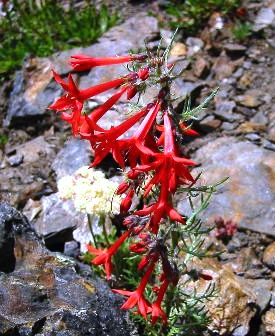- Series:Plants, Transcript English
Matthew 6:28-29
And why take ye thought for raiment? Consider the lilies of the field, how they grow; they toil not, neither do they spin: And yet I say unto you, That even Solomon in all his glory was not arrayed like one of these.
What color is the scarlet gilia? Well, that depends on where and when it’s blooming. Despite its name, the scarlet gilia can be red, pink, and even white.

The higher-elevation plants change over to white flowers because they have a new pollinator. As the hummingbird population decreases, hawkmoths take over. During this transition, the flower produces pink blossoms as it invites both of its pollinators. Once the hummingbirds are gone, the hawkmoth takes over. The hawkmoths pollinate at night, so they prefer white flowers, which are easier to see in the dark. Scientists were amazed by the fact that the color changes take place exactly when pollination shifts from hummingbird to moth. As one startled scientist put it, these plants cannot be considered passive in their environment.
Who taught the scarlet gilia when and how to change the color of its flowers? Who taught it that hummingbirds will be attracted to red flowers? Or that hawkmoths will be attracted to white flowers? The scarlet gilia may be clever, but only our all-wise Creator could have given this knowledge and ability to the plant.
Prayer:
Dear Father, I thank You that the wisdom with which You designed the creation is there for all to see. As I strive against the world’s denial of Your intimate involvement in Your creation, help me to see more clearly that the creation is Yours and that it glorifies You. In Jesus’ Name. Amen.
Notes:
Bennett, D. D. Scarlet gilia: Flowering Chameleon. Science News, Feb. 1985, p. 69. Photo: Scarlet gilia. Courtesy of Walter Siegmund. (CC BY-SA 3.0)
